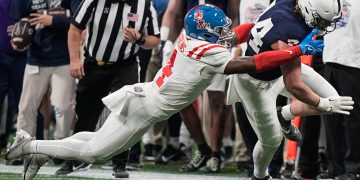The University of Mississippi now stands at a crossroads after two campus government organizations have passed resolutions to relocate the Confederate monument: move the statue to the Confederate cemetery, or allow it to remain in the Circle
Though the position the university is in is contentious, it isn’t new — Ole Miss has found itself here, in the controversy of Confederate symbolism, time after time during the last 20 years.
“At each juncture, it takes either a horrible incident or some real bold leadership to make these things happen,” former assistant provost and long-time professor Donald Cole said about the university’s history with confronting Confederate symbols.
In 1997, then-Chancellor Robert Khayat banned all sticks from Vaught-Hemingway Stadium during football games, which largely ended the tradition of waving Confederate flags at football games.
Six years later, in 2003, the administration removed Colonel Reb, a white plantation owner, as the official sideline mascot for the university.
“I can remember meeting with all the athletic coaches and them saying how much it hurt their athletes — having that caricature on the sidelines — and them trying to recruit with that hanging around their neck,” former Dean of Students Sparky Reardon said.
A student committee formed in 2010 decided to change the mascot from Colonel Reb to Rebel the Black Bear, marking one of the first student-led initiatives to remove Confederate icons from the Ole Miss campus.
“To me, that was a huge year,” said Alex McDaniel, former editor-in-chief of The Daily Mississippian. “I just think in the past, important decisions came from administration or other campus officials, but students led the effort that year.”
However, the decision, like those that preceded it, was met with considerable opposition.
In 2015, the university administration decided to remove the Mississippi state flag — which bears the Confederate battle emblem — from campus, after several campus government organizations voted to remove the flag.
“When the university first rid itself of the Confederate flag, that was a gigantic move and of course, a lot of people at the time appreciated it,” Cole said. “But now, when we look back, even more people say that was the right thing to do, that was the moral thing to do.”
The Ku Klux Klan protested the removal of the flag in the days leading up to the vote, but the flag was ultimately removed.
“Every time the university tries to move itself forward, there are people who are not part of the university, who respond and act for their own good, and they use the university for their own causes,” Reardon said. “Dammit, I’m tired of the university being used.”
Little by little, the university has inched toward the climax it reached Tuesday night. The Associated Student Body is now leading the charge to relocate the statue and distance the university from the Confederate history that continues to color its present, and the decision will ultimately rest in the hands of the administration at the Lyceum as it continues its process through the university.



























